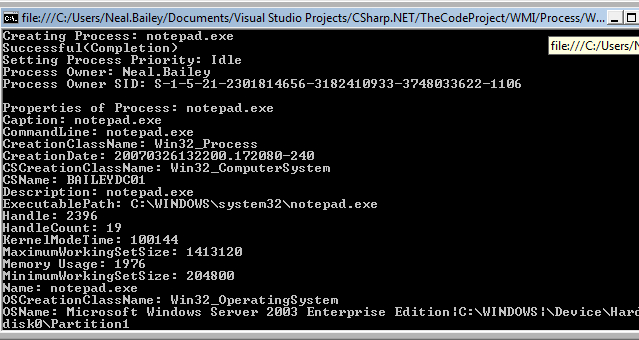
Introduction
This is the second article in the series of articles How To: (Almost) Everything In WMI via C#.
This article focuses on the Win32_Process class within the root\CIMV2 namespace. This library exposes all the properties and methods encapsulated in this namespace to your application (and there are quite a few). Using this library, you can enumerate properties of the processes on your machines, kick off processes, terminate processes, enumerate processes, and gather significant details regarding your processes. The library facilitates running any of these tasks on local or remote workstations.
Consideration
Please do not send me emails with instructions on how to perform these tasks using .NET native classes. That is not the point of these articles. I'm composing these articles for the purpose of demonstrating how to use WMI within C#.NET with the System.Management namespace. Also note that WMI is a bit slower than the .NET classes so if you have no specific need to use WMI, you should probably be using System.Diagnostics.Process instead.
Using the Attached Code
Methods (Local Machine or Remote Machine)
CreateProcess(string processPath) - Starts a process GetProcessOwner(string processName) - Gets the user name of the process owner GetProcessOwnerSID(string processName) - Gets the SID of the process owner ProcessProperties(string processName) - Gets the 60+ property values of the process RunningProcesses() - Gets the names of all the running processes (can be changed) SetPriority(string processName, ProcessPriority.priority priority) - Changes the process priority TerminateProcess(string processName) - Kills the process
Instantiate the Local Provider
ProcessLocal processObject = new ProcessLocal();
Walkthrough All the Methods
Console.WriteLine("Fetching Running Processes: ");
foreach (string eachProcess in processObject.RunningProcesses())
{
Console.WriteLine("Process: " + eachProcess);
}
Console.WriteLine("");
string processName = "notepad.exe";
Console.WriteLine("Creating Process: " + processName);
Console.WriteLine(processObject.CreateProcess(processName));
Console.WriteLine("Setting Process Priority: Idle");
processObject.SetPriority(processName, ProcessPriority.priority.IDLE);
Console.WriteLine("Process Owner: " + processObject.GetProcessOwner(processName));
Console.WriteLine("Process Owner SID: " +
processObject.GetProcessOwnerSID(processName));
Console.WriteLine("");
Console.WriteLine("Properties of Process: " + processName);
foreach (string property in processObject.ProcessProperties(processName))
{
Console.WriteLine(property);
}
Console.WriteLine("");
Console.WriteLine("Killing Process: " + processName);
processObject.TerminateProcess(processName);
Console.WriteLine("Process Terminated");
Console.ReadLine();
Remote System Processes
In order to run the code above against a remote machine, you must instantiate the ProcessRemote class. During this instantiation, you need to either send in explicit credentials or you can send in null values if you're running this on a workstation on a domain, logged in with a domain account with the appropriate permissions to perform these tasks against the remote workstation.
Instantiating the Remote Provider
ProcessRemote processObject =
new ProcessRemote(userName,
password,
domain,
machine/ip);
Connecting to a Remote Machine Where You Want to Use The Domain Credentials from the LoggedIn User
ProcessRemote processObject =
new ProcessRemote(null,
null,
null,
machine/ip);
Using a Service Account to kick off a Remote Process
ProcessRemote processObject =
new ProcessRemote("neal.bailey",
"S3cr3tPa$$",
"BAILEYSOFT",
"192.168.2.1");
processObject.OneOfTheMethodsDetailedAbove;
Conclusion
The WMI (Windows Management Instrumentation) provider is considerably slower than the native .NET classes. At first it may seem pointless to use WMI for process management tasks considering the ease of use of the .NET System.Diagnostics.Process classes, however a lot of developers out there spent a lot of time learning WMI and would like to have it available in their toolbox.
History
- Originally submitted on 26th March, 2007
I'm a professional .NET software developer and proud military veteran. I've been in the software business for 20+ years now and if there's one lesson I have learned over the years, its that in this industry you have to be prepared to be humbled from time to time and never stop learning!
 General
General  News
News  Suggestion
Suggestion  Question
Question  Bug
Bug  Answer
Answer  Joke
Joke  Praise
Praise  Rant
Rant  Admin
Admin 








